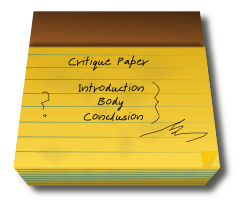Were you assigned or asked by your professor to write a critique paper? It’s easy to write one. Just follow the following four steps in writing a critique paper and three steps in presenting it, then you’re ready to go.
One of the students’ requirements I specified in the course module is a critique paper. Just so everyone benefits from the guide I prepared for that class, I share it here.
To standardize the format they use in writing a critique paper, I came up with the following steps to make their submissions worthwhile.
Since they are graduate students, more is expected of them. Hence, most of the verbs I use in writing the lesson’s objectives reside in the domain of higher thinking skills or HOTS. Developing the students’ critical thinking skills will help them analyze future problems and propose solutions that embody environmental principles thus resonate desirable outcomes aligned with the goal of sustainable development.
Table of Contents
Step-by-Step Procedure in Writing a Critique Paper
I quickly wrote this simple guide on writing a critique paper to help you evaluate any composition you want to write about. It could be a book, a scientific article, a gray paper, or whatever your professor assigns. I integrated the essence of the approach in this article.
The critique paper essentially comprises two major parts, namely the:
1) Procedure in Writing a Critique Paper, and the
2) Format of the Critique Paper.
First, you will need to know the procedure that will guide you in evaluating a paper. Second, the format of the critique paper refers to how you present it so that it becomes logical and scholarly in tone.
The Four Steps in Writing a Critique Paper
Here are the four steps in writing a critique paper:
To write a good critique paper, it pays to adhere to a smooth flow of thought in your evaluation of the piece. You will need to introduce the topic, analyze, interpret, then conclude it.
Introduce the Discussion Topic
Introduce the topic of the critique paper. To capture the author’s idea, you may apply the 5Ws and 1H approach in writing your technical report.
That means, when you write your critique paper, you should be able to answer the Why, When, Where, What, Who, and How questions. Using this approach prevents missing out on the essential details. If you can write a critique paper that adheres to this approach, that would be excellent.
Here’s a simplified example to illustrate the technique:
The news article by John Doe was a narrative about a bank robbery. Accordingly, a masked man (Who) robbed a bank (What) the other day (When) next to a police station (Where). He did so in broad daylight (How). He used a bicycle to escape from the scene of the crime (How). In his haste, he bumped into a post. His mask fell off; thus, everyone saw his face, allowing witnesses to describe him. As a result, he had difficulty escaping the police, who eventually retrieved his loot and put him in jail because of his wrongdoing (Why).
Hence, you give details about the topic, in this case, a bank robbery. Briefly describe what you want to tell your audience. State the overall purpose of writing the piece and its intention.
Is the essay written to inform, entertain, educate, raise an issue for debate, and so on? Don’t parrot or repeat what the writer wrote in his paper. And write a paragraph or a few sentences as succinctly as you can.
Analyze
Analyze means to break down the abstract ideas presented into manageable bits.
What are the main points of the composition? How was it structured? Did the view expressed by the author allow you, as the reader, to understand?
In the example given above, it’s easy to analyze the event as revealed by the chain of events. How do you examine the situation?
The following steps are helpful in the analysis of information:
- Ask yourself what your objective is in writing the critique paper. Come up with a guidepost in examining it. Are you looking at it with some goal or purpose in mind? Say you want to find out how thieves carry out bank robberies. Perhaps you can categorize those robberies as either planned or unplanned.
- Find out the source, or basis, of the information that you need. Will you use the paper as your source of data, or do you have corroborating evidence?
- Remove unnecessary information from your data source. Your decision to do so depends on your objective. If there is irrelevant data, remove it from your critique.
We can use an analogy here to clearly explain the analysis portion.
If you want to split a log, what would you do? Do you use an ax, a chainsaw, or perhaps a knife? The last one is out of the question. It’s inappropriate.
Thus, it would be best if you defined the tools of your analysis. Tools facilitate understanding and allow you to make an incisive analysis.
Read More: 5 Tools in Writing the Analysis Section of the Critique Paper
Now, you are ready to interpret the article, book, or any composition once the requisites of analysis are in place.
Interpret
Visualize the event in your mind and interpret the behavior of actors in the bank robbery incident. You have several actors in that bank heist: the robber, the police, and the witnesses of the crime.
While reading the story, it might have occurred to you that the robber is inexperienced. We can see some discrepancies in his actions.
Imagine, his mode of escape is a bicycle. What got into him? Maybe he did not plan the robbery at all. Besides, there was no mention that the robber used a gun in the heist.
That fact confirms the first observation that he was not ready at all. Escaping the scene of the crime using a bicycle with nothing to defend himself once pursued? He’s insane. Unimaginable. He’s better off sleeping at home and waiting for food to land on his lap if food will come at all.
If we examine the police’s response, they were relatively quick. Right after the robber escaped the crime scene, they appeared to remedy the situation. The robber did not put up a fight.
What? With bare knuckles? It makes little sense.
If we look at the witnesses’ behavior, we can discern that perhaps they willingly informed the police of the bank robber’s details. They were not afraid. And that’s because the robber appears to be unarmed. But there was no specific mention of it.
Narrate the importance of each of the different sections or paragraphs. How does the write-up contribute to the overall picture of the issue or problem being studied?
Assess or Evaluate
Finally, judge whether the article was a worthwhile account after all. Did it meet expectations? Was it able to convey the information most efficiently? Or are there loopholes or flaws that should have been mentioned?
Format of Presenting the Critique Paper
The logical format in writing a critique paper comprises at least three sections: the introduction, the body, and the conclusion. This approach is systematic and achieves a good flow that readers can follow.
Introduction
Include the title and name of the author in your introduction. Make a general description of the topic being discussed, including the author’s assumptions, inferences, or contentions. Find out the thesis or central argument, which will be the basis of your discussion.
The robbery example appears to be inappropriate to demonstrate this section, as it is so simple. So we level up to a scientific article.
In any scientific article, there is always a thesis that guides the write-up. A thesis is a statement that expresses what the author believes in and tries to test in his study. The investigation or research converges (ideally) to this central theme as the author’s argument.
You can find the thesis in the paper’s hypothesis section. That’s because a hypothesis is a tentative thesis. Hypo means “below or under,” meaning it is the author’s tentative explanation of whatever phenomenon he tackles.
If you need more information about this, please refer to my previous post titled “How to Write a Thesis.”
How is the introduction of a critique paper structured? It follows the general guidelines of writing from a broad perspective to more specific concerns or details. See how it’s written here: Writing a Thesis Introduction: from General to Specific.
You may include the process you adopted in writing the critique paper in this section.
Body
The body of the paper includes details about the article being examined. It is here where you place all those musings of yours after applying the analytical tools.
This section is similar to the results and discussion portion of a scientific paper. It describes the outcome of your analysis and interpretation.

In explaining or expressing your argument, substantiate it by citing references to make it believable. Make sure that those references are relevant as well as timely. Don’t cite references that are so far out in the past. These, perhaps, would not amount to a better understanding of the topic at hand. Find one that will help you understand the situation.
Besides, who wants to adopt the perspective of an author who has not even got hold of a mobile phone if your paper is about using mobile phones to facilitate learning during the pandemic caused by COVID-19? Find a more recent one that will help you understand the situation.
Objectively examine the major points presented by the author by giving details about the work. How does the author present or express the idea or concept? Is he (or she) convincing the way he/she presents his/her paper’s thesis?
Well, I don’t want to be gender-biased, but I find the “he/she” term somewhat queer. I’ll get back to the “he” again, to represent both sexes.
I mention the gender issue because the literature says that there is a difference in how a person sees things based on gender. For example, Ragins & Sundstrom (1989) observed that it would be more difficult for women to obtain power in the organization than men. And there’s a paper on gender and emotions by Shields et al. (2006), although I wouldn’t know the outcome of that study as it is behind a paywall. My point is just that there is a difference in perspective between men and women. Alright.
Therefore, always find evidence to support your position. Explain why you agree or disagree with the author. Point out the discrepancies or strengths of the paper.
Conclusion
Well, everything has an end. Write a critique paper that incorporates the key takeaways of the document examined. End the critique with an overall interpretation of the article, whatever that is.
Why do you think is the paper relevant in the course’s context that you are taking? How does it contribute to say, the study of human behavior (in reference to the bank robbery)? Are there areas that need to be considered by future researchers, investigators, or scientists? That will be the knowledge gap that the next generation of researchers will have to look into.
If you have read up to this point, then thank you for reading my musings. I hope that helped you clarify the steps in writing a critique paper. A well-written critique paper depends on your writing style.
Read More: How to Write an Article with AI: A Guide to Using AI for Article Creation and Refinement
Notice that my writing style changes based on the topic that I discuss. Hence, if your professor assigns you a serious, rigorous, incisive, and detailed analysis of a scientific article, then that is the way to go. Adopt a formal mode in your writing.
Final Tip: Find a paper that is easy for you to understand. In that way, you can clearly express your thoughts. Write a critique paper that rocks!
Related Reading
Master Content Analysis: An All-in-One Guide
References
Ragins, B. R., & Sundstrom, E. (1989). Gender and power in organizations: A longitudinal perspective. Psychological bulletin, 105(1), 51.
Shields, S. A., Garner, D. N., Di Leone, B., & Hadley, A. M. (2006). Gender and emotion. In Handbook of the sociology of emotions (pp. 63-83). Springer, Boston, MA.
© 2020 November 20 P. A. Regoniel
[cite]



Thank you..for your idea ..it was indeed helpful
Glad it helped you Preezy.
This is extremely helpful. Thank you very much!
Thanks for sharing tips on how to write critique papers. This article is very informative and easy to understand.
Welcome. Thank you for your appreciation.